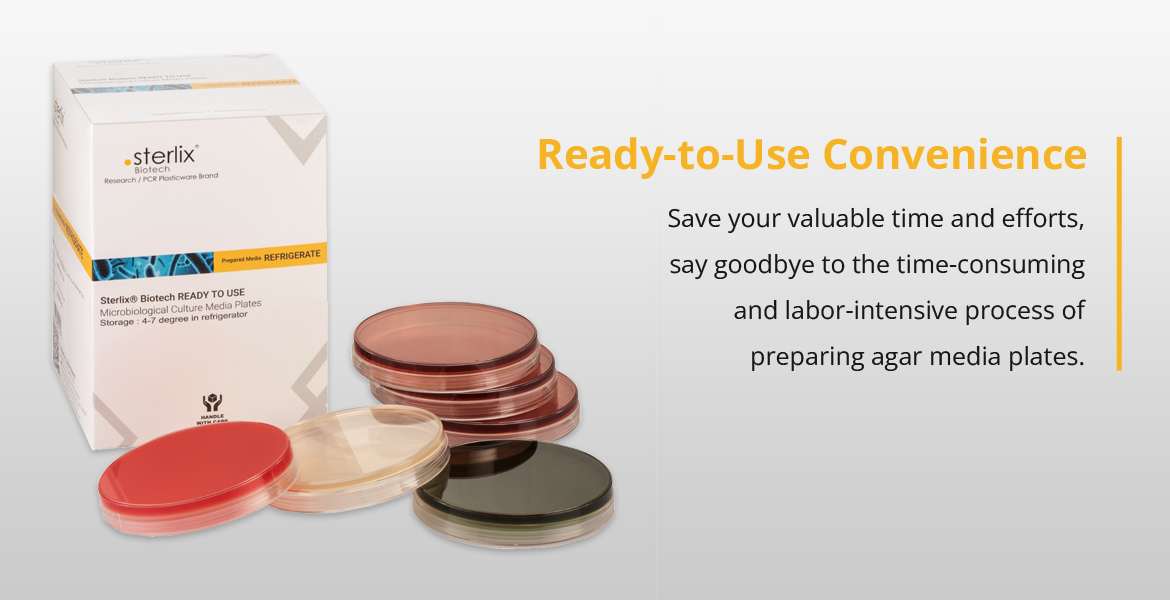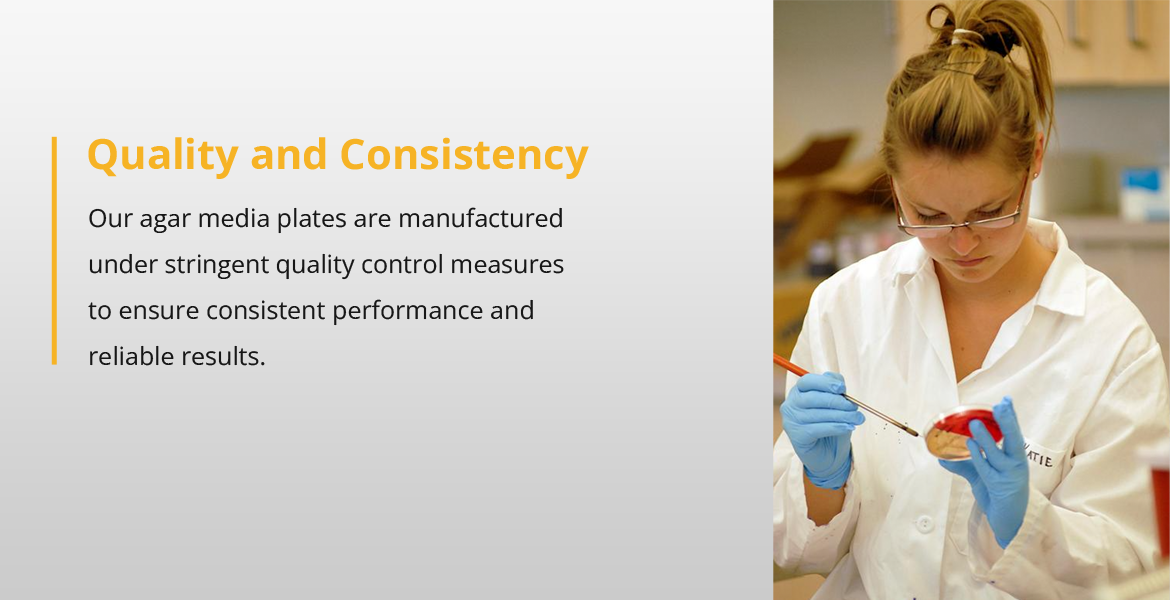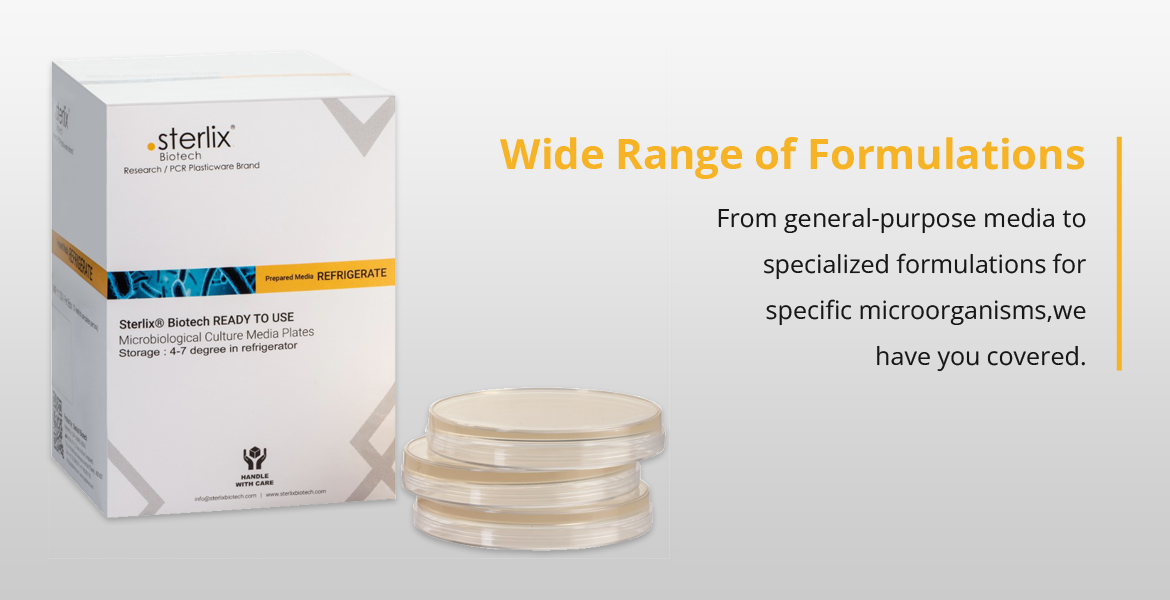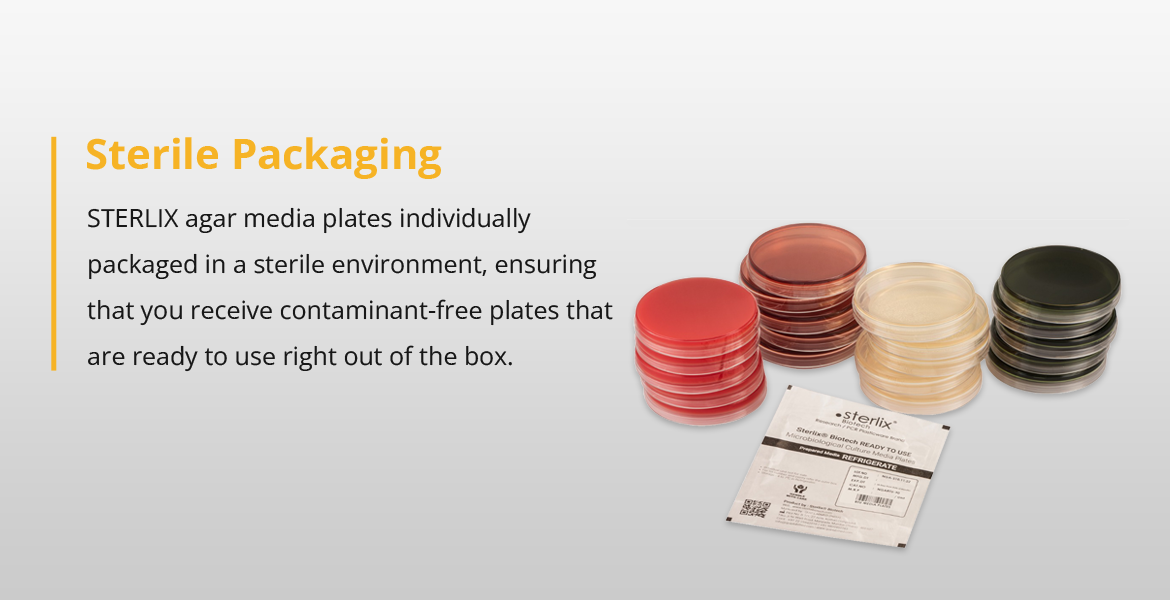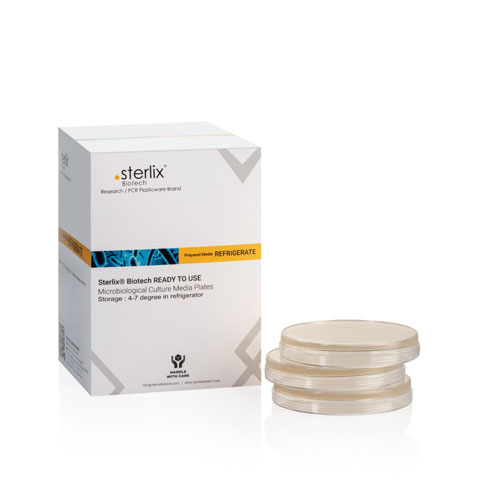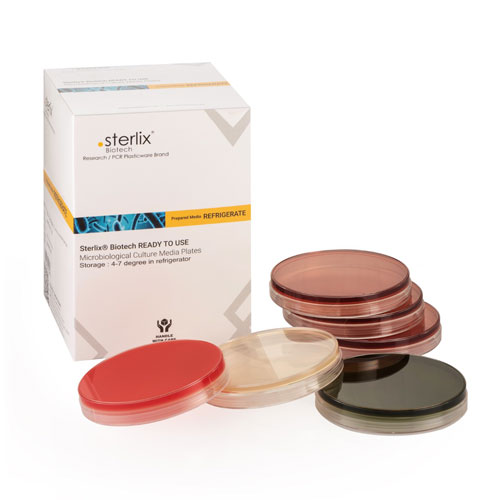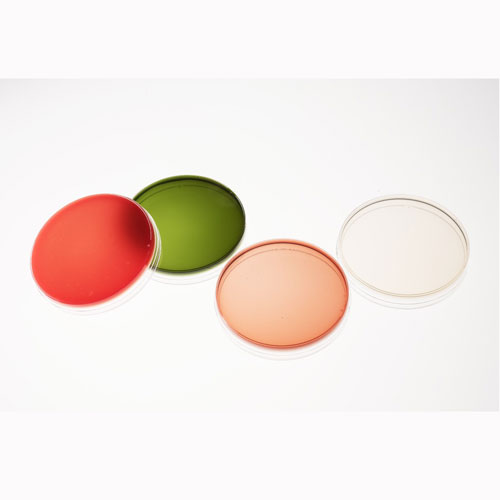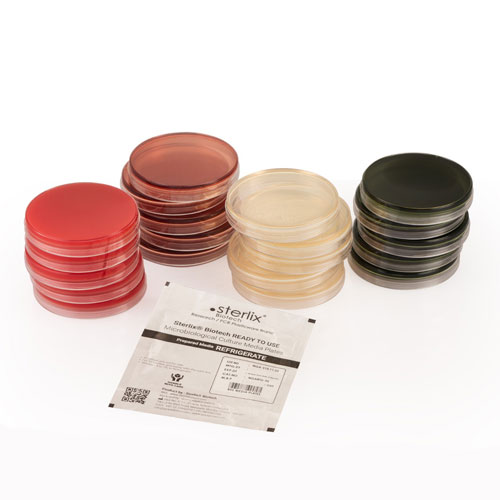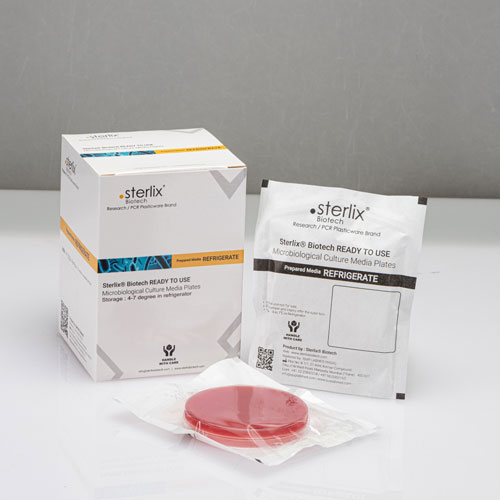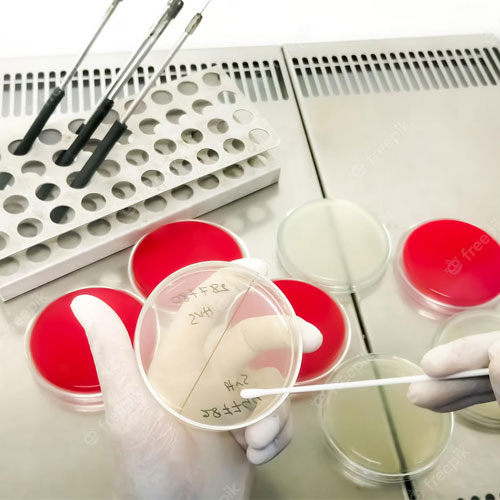Introducing STERLIX®: Ready-to-Use Agar Media Plates
Experience convenience and efficiency like never before with STERLIX®, your trusted
partner for high-quality agar media plates. Designed for seamless laboratory workflows,
STERLIX® provides you with a hassle-free solution for microbial culture and analysis.
Whether you are a researcher, scientist, or student, STERLIX® is the perfect choice to meet
your agar media needs.
Key Features
Ready-to-Use Convenience: Say goodbye to the time-consuming and labour-intensive process of preparing agar media plates. With STERLIX, you can skip the preparation step and focus directly on your experiments, saving valuable time and effort.
Quality and Consistency: STERLIX® is synonymous with superior quality. Our agar media plates are manufactured under stringent quality control measures to ensure consistent performance and reliable results. Each plate is meticulously formulated with the finest ingredients, meeting the highest industry standards.
Sterile Packaging: We understand the criticality of maintaining sterility in your experiments. STERLIX® agar media plates are individually packaged in a sterile environment, ensuring that you receive contaminant-free plates that are ready to use right out of the box.
Wide Range of Formulations: STERLIX® offers an extensive selection of agar media formulations to cater to diverse research needs. From general-purpose media to specialized formulations for specific microorganisms, we have you covered. Choose from our comprehensive range of agar media plates to support your unique applications.
Convenient Labelling: Keeping track of your cultures is made easy with STERLIX®. Each agar media plate is clearly labelled with necessary information, such as media composition, batch number, and expiry date. This allows for efficient identification and documentation of your experiments.
Shelf Life: STERLIX® agar media plates boast an extended shelf life, ensuring the longevity of your research supplies. Our carefully designed Individual packaging and formulation processes contribute to the longevity of the plates, giving you peace of mind and reducing waste.
Exceptional Customer Support: At STERLIX®, we value your satisfaction and success. Our dedicated customer support team is always ready to assist you with any queries or concerns you may have. We strive to provide timely and effective solutions to ensure a smooth experience with our products.
Unlock the potential of your microbiology research with STERLIX agar media plates. Simplify your laboratory workflows, achieve reliable results, and save valuable time and resources. Trust STERLIX® for all your agar media needs.
Product Range
STERLIX® 5% Sheep Blood Ready To Use Agar Plate
View Details
A 5% Sheep Blood Agar Plate, also known as Sheep Blood Agar (SBA), is a culture medium commonly used in microbiology laboratories. It is a nutrient-rich agar supplemented with 5% sheep blood, typically obtained from aseptically collected sheep blood.
The addition of sheep blood to the agar serves multiple purposes:
Enrichment: The presence of blood provides additional nutrients, growth factors, and enzymes that support the growth of a wide range of microorganisms.
Differential Properties: Sheep Blood Agar can help differentiate bacteria based on their hemolytic activity. Hemolysis refers to the lysis or destruction of red blood cells by certain bacterial enzymes. The different patterns of hemolysis can provide important information for the identification and classification of bacteria.
a. Alpha Hemolysis: Partial hemolysis that appears as a greenish discoloration around bacterial colonies.
b. Beta Hemolysis: Complete hemolysis that results in a clear zone around bacterial colonies, indicating the complete destruction of red blood cells
c. Gamma Hemolysis: No hemolysis or change in the appearance of the blood agar around bacterial colonies.
The 5% Sheep Blood Agar Plate is frequently used for various purposes, including the isolation and identification of pathogenic bacteria, particularly those associated with respiratory infections, such as Streptococcus pneumoniae and Streptococcus pyogenes.
The medium provides a favorable environment for bacterial growth and allows for the observation of distinct hemolytic patterns, aiding in the differentiation and identification of bacterial species based on their hemolytic characteristics.
The addition of sheep blood to the agar serves multiple purposes:
Enrichment: The presence of blood provides additional nutrients, growth factors, and enzymes that support the growth of a wide range of microorganisms.
Differential Properties: Sheep Blood Agar can help differentiate bacteria based on their hemolytic activity. Hemolysis refers to the lysis or destruction of red blood cells by certain bacterial enzymes. The different patterns of hemolysis can provide important information for the identification and classification of bacteria.
a. Alpha Hemolysis: Partial hemolysis that appears as a greenish discoloration around bacterial colonies.
b. Beta Hemolysis: Complete hemolysis that results in a clear zone around bacterial colonies, indicating the complete destruction of red blood cells
c. Gamma Hemolysis: No hemolysis or change in the appearance of the blood agar around bacterial colonies.
The 5% Sheep Blood Agar Plate is frequently used for various purposes, including the isolation and identification of pathogenic bacteria, particularly those associated with respiratory infections, such as Streptococcus pneumoniae and Streptococcus pyogenes.
The medium provides a favorable environment for bacterial growth and allows for the observation of distinct hemolytic patterns, aiding in the differentiation and identification of bacterial species based on their hemolytic characteristics.
STERLIX® Macconkey Ready To Use Agar Plate
View Details
MacConkey agar plate, named after its developer Alfred Theodore MacConkey, is a selective and differential culture medium used in microbiology laboratories. It is primarily employed for the isolation and differentiation of gram-negative bacteria, particularly members of the family Enterobacteriaceae.
The key components of MacConkey agar include:
Bile salts and crystal violet: These selective agents inhibit the growth of gram-positive bacteria, allowing for the selective isolation of gram-negative bacteria.
Lactose: MacConkey agar contains lactose as the carbohydrate source. It helps differentiate bacteria based on their ability to ferment lactose.
Neutral red: This pH indicator turns colonies that ferment lactose into pink or red color, aiding in the differentiation of lactose fermenters from non-fermenters.
MacConkey agar can distinguish bacterial colonies based on the following characteristics:
Lactose fermenters: Bacteria capable of fermenting lactose produce acid as a byproduct, causing the agar surrounding their colonies to turn pink or red.
Non-lactose fermenters: Bacteria that do not ferment lactose do not produce acid and, therefore, do not cause a color change. These colonies typically remain colorless or pale.
Neutral colonies: Some organisms, such as Salmonella and Shigella species, do not ferment lactose but can grow on MacConkey agar. These colonies appear as transparent or colorless due to their inability to metabolize lactose.
MacConkey agar is particularly useful for the identification and differentiation of enteric pathogens, including Escherichia coli, Klebsiella pneumoniae, Enterobacter aerogenes, and Proteus mirabilis, among others. It plays a vital role in clinical diagnostics, allowing for the detection of pathogens associated with urinary tract infections, gastrointestinal disorders, and other related conditions.
It's important to note that MacConkey agar is a selective medium and is not suitable for the growth of fastidious or non-enteric bacteria. For the isolation of other types of microorganisms, different selective and differential media are used.
The key components of MacConkey agar include:
Bile salts and crystal violet: These selective agents inhibit the growth of gram-positive bacteria, allowing for the selective isolation of gram-negative bacteria.
Lactose: MacConkey agar contains lactose as the carbohydrate source. It helps differentiate bacteria based on their ability to ferment lactose.
Neutral red: This pH indicator turns colonies that ferment lactose into pink or red color, aiding in the differentiation of lactose fermenters from non-fermenters.
MacConkey agar can distinguish bacterial colonies based on the following characteristics:
Lactose fermenters: Bacteria capable of fermenting lactose produce acid as a byproduct, causing the agar surrounding their colonies to turn pink or red.
Non-lactose fermenters: Bacteria that do not ferment lactose do not produce acid and, therefore, do not cause a color change. These colonies typically remain colorless or pale.
Neutral colonies: Some organisms, such as Salmonella and Shigella species, do not ferment lactose but can grow on MacConkey agar. These colonies appear as transparent or colorless due to their inability to metabolize lactose.
MacConkey agar is particularly useful for the identification and differentiation of enteric pathogens, including Escherichia coli, Klebsiella pneumoniae, Enterobacter aerogenes, and Proteus mirabilis, among others. It plays a vital role in clinical diagnostics, allowing for the detection of pathogens associated with urinary tract infections, gastrointestinal disorders, and other related conditions.
It's important to note that MacConkey agar is a selective medium and is not suitable for the growth of fastidious or non-enteric bacteria. For the isolation of other types of microorganisms, different selective and differential media are used.
STERLIX® Chocolate Ready To Use Agar Plate
View Details
Chocolate agar plate, also known as heated blood agar or Thayer-Martin agar, is a specialized culture medium used in microbiology laboratories. It is called "chocolate" agar because the heat used during its preparation gives the medium a brown color, resembling melted chocolate.
The main component of a Chocolate agar plate is blood, usually sheep blood, which provides essential nutrients for the growth of fastidious bacteria. The preparation process involves heating the blood agar, which causes the release of various nutrients and growth factors from the red blood cells, making them more readily available for bacterial growth.
Chocolate agar plates are commonly used for the isolation and cultivation of fastidious organisms, particularly Neisseria species, including Neisseria gonorrhoeae and Neisseria meningitidis. These bacteria have specific growth requirements and may be difficult to culture on standard media.
The chocolate agar plate provides a rich and supportive environment for the growth of these bacteria by supplying the necessary nutrients, such as vitamins, amino acids, and other growth factors. The heated blood also creates a favorable environment for the growth of other fastidious organisms.
Additionally, the chocolate agar plate can be supplemented with antibiotics or selective agents to inhibit the growth of normal flora or unwanted bacteria, allowing for the selective isolation of specific pathogens.
The use of Chocolate agar plates, along with specific incubation conditions, helps in the diagnosis and identification of pathogenic bacteria, especially those associated with sexually transmitted infections (such as N. gonorrhoeae) and meningitis (such as N. meningitidis).
The main component of a Chocolate agar plate is blood, usually sheep blood, which provides essential nutrients for the growth of fastidious bacteria. The preparation process involves heating the blood agar, which causes the release of various nutrients and growth factors from the red blood cells, making them more readily available for bacterial growth.
Chocolate agar plates are commonly used for the isolation and cultivation of fastidious organisms, particularly Neisseria species, including Neisseria gonorrhoeae and Neisseria meningitidis. These bacteria have specific growth requirements and may be difficult to culture on standard media.
The chocolate agar plate provides a rich and supportive environment for the growth of these bacteria by supplying the necessary nutrients, such as vitamins, amino acids, and other growth factors. The heated blood also creates a favorable environment for the growth of other fastidious organisms.
Additionally, the chocolate agar plate can be supplemented with antibiotics or selective agents to inhibit the growth of normal flora or unwanted bacteria, allowing for the selective isolation of specific pathogens.
The use of Chocolate agar plates, along with specific incubation conditions, helps in the diagnosis and identification of pathogenic bacteria, especially those associated with sexually transmitted infections (such as N. gonorrhoeae) and meningitis (such as N. meningitidis).
STERLIX® Müller-Hinton Ready To Use Agar (MHA) Plate
View Details
Müller-Hinton agar (MHA) is a common culture medium used in microbiology laboratories, particularly for antibiotic susceptibility testing of bacteria. It was developed by J. Hinton in collaboration with E. Müller in the 1940s.
Müller-Hinton agar is a non-selective and non-differential medium with a standardized composition. It contains a combination of protein digests, starch, and beef extract that provide essential nutrients for bacterial growth. The agar itself acts as a solidifying agent to support colony formation.
MHA is widely used for the Kirby-Bauer disk diffusion method, which is employed to determine the susceptibility or resistance of bacteria to various antibiotics. In this method, paper disks impregnated with specific antibiotics are placed onto the surface of the MHA plate, and the growth inhibition zones around the disks are measured after incubation. The results help guide clinicians in choosing appropriate antibiotics for the treatment of bacterial infections.
The standardized composition of Müller-Hinton agar ensures consistent growth and reproducible results. Its low calcium and magnesium content minimize the inhibitory effects of these ions on antibiotic activity, allowing for accurate interpretation of susceptibility testing results.
Overall, Müller-Hinton agar provides a reliable and standardized medium for antibiotic susceptibility testing and is widely used in clinical microbiology laboratories.
Müller-Hinton agar is a non-selective and non-differential medium with a standardized composition. It contains a combination of protein digests, starch, and beef extract that provide essential nutrients for bacterial growth. The agar itself acts as a solidifying agent to support colony formation.
MHA is widely used for the Kirby-Bauer disk diffusion method, which is employed to determine the susceptibility or resistance of bacteria to various antibiotics. In this method, paper disks impregnated with specific antibiotics are placed onto the surface of the MHA plate, and the growth inhibition zones around the disks are measured after incubation. The results help guide clinicians in choosing appropriate antibiotics for the treatment of bacterial infections.
The standardized composition of Müller-Hinton agar ensures consistent growth and reproducible results. Its low calcium and magnesium content minimize the inhibitory effects of these ions on antibiotic activity, allowing for accurate interpretation of susceptibility testing results.
Overall, Müller-Hinton agar provides a reliable and standardized medium for antibiotic susceptibility testing and is widely used in clinical microbiology laboratories.
STERLIX® Nutrient Ready To Use Agar Plate
View Details
Nutrient agar plate, also known as general-purpose agar, is a basic and versatile culture medium used in microbiology laboratories. It provides a nutrient-rich environment that supports the growth of a wide variety of microorganisms, including bacteria, yeasts, and molds.
The composition of nutrient agar typically includes the following key components:
Peptone: A mixture of partially digested proteins that serves as a nitrogen source for bacterial growth.
Beef extract: A water-soluble extract derived from beef tissue, containing a variety of nutrients such as vitamins, minerals, and organic compounds.
Agar: A polysaccharide obtained from marine algae that solidifies the medium, providing a surface for microbial colony formation.
Water: Provides a solvent for the other components and helps maintain the proper consistency of the agar medium.
Nutrient agar plates are widely used for several purposes in microbiology, including:
General Culturing: Nutrient agar supports the growth of a broad range of microorganisms, making it suitable for routine cultivation and maintenance of laboratory cultures.
Enumeration: Nutrient agar plates can be used for counting the number of viable microorganisms in a given sample, providing information about the microbial load or population density.
Isolation: Nutrient agar plates can be used to isolate and separate individual microbial colonies from a mixed population. Streaking or serial dilution techniques are commonly employed for this purpose.
Colony Morphology: Nutrient agar allows for the observation of colony morphology, which can aid in the initial identification of microorganisms based on their size, shape, color, texture, or other visible characteristics.
Nutrient agar plates are considered non-selective, meaning they support the growth of a wide range of microorganisms without inhibiting any particular group. This makes nutrient agar a versatile medium for general laboratory use. However, it's important to note that for specific purposes, such as the isolation of specific organisms or the differentiation of particular bacterial types, specialized selective and differential media may be more appropriate.
The composition of nutrient agar typically includes the following key components:
Peptone: A mixture of partially digested proteins that serves as a nitrogen source for bacterial growth.
Beef extract: A water-soluble extract derived from beef tissue, containing a variety of nutrients such as vitamins, minerals, and organic compounds.
Agar: A polysaccharide obtained from marine algae that solidifies the medium, providing a surface for microbial colony formation.
Water: Provides a solvent for the other components and helps maintain the proper consistency of the agar medium.
Nutrient agar plates are widely used for several purposes in microbiology, including:
General Culturing: Nutrient agar supports the growth of a broad range of microorganisms, making it suitable for routine cultivation and maintenance of laboratory cultures.
Enumeration: Nutrient agar plates can be used for counting the number of viable microorganisms in a given sample, providing information about the microbial load or population density.
Isolation: Nutrient agar plates can be used to isolate and separate individual microbial colonies from a mixed population. Streaking or serial dilution techniques are commonly employed for this purpose.
Colony Morphology: Nutrient agar allows for the observation of colony morphology, which can aid in the initial identification of microorganisms based on their size, shape, color, texture, or other visible characteristics.
Nutrient agar plates are considered non-selective, meaning they support the growth of a wide range of microorganisms without inhibiting any particular group. This makes nutrient agar a versatile medium for general laboratory use. However, it's important to note that for specific purposes, such as the isolation of specific organisms or the differentiation of particular bacterial types, specialized selective and differential media may be more appropriate.
STERLIX® C.L.E.D Ready To Use Agar Plate
View Details
CLED agar stands for Cysteine-Lactose-Electrolyte-Deficient agar. It is a selective and differential medium used in microbiology laboratories for the isolation and differentiation of urinary tract pathogens, especially Escherichia coli and other coliform bacteria. The composition of CLED agar includes cysteine (a sulfur-containing amino acid), lactose (a carbohydrate), and electrolytes. The medium lacks certain electrolytes, such as sodium chloride, which inhibits the swarming of Proteus species. CLED agar allows the growth of coliform bacteria while inhibiting the growth of non-coliform bacteria, making it suitable for urine culture and identification of urinary tract infections.
STERLIX® XLD Ready To Use Agar Plate
View Details
XLD agar (Xylose Lysine Deoxycholate agar) is a selective and differential culture medium commonly used in microbiology laboratories for the isolation and differentiation of Salmonella and Shigella species from clinical and food samples.
The key components of XLD agar include:
Xylose: XLD agar contains xylose as the fermentable carbohydrate. Salmonella species can ferment xylose, leading to acid production and a pH decrease, which is reflected by a color change in the medium.
Lysine: XLD agar contains lysine, an amino acid. Lysine decarboxylase activity is an important characteristic used for differentiating Salmonella and Shigella species.
Deoxycholate: This bile salt compound inhibits the growth of gram-positive bacteria, making XLD agar selective for gram-negative bacteria, including Salmonella and Shigella.
Phenol red: XLD agar contains phenol red, a pH indicator. It turns yellow in the presence of acid produced during carbohydrate fermentation.
In XLD agar, the differentiation of bacterial colonies is based on their ability to ferment xylose and produce specific metabolic byproducts. The typical characteristics observed on XLD agar include:
Salmonella species: These bacteria can ferment xylose, producing acid and turning the agar yellow. Salmonella colonies often appear as black-centered colonies due to the production of hydrogen sulfide (H2S) during the breakdown of cysteine.
Shigella species: Shigella organisms do not ferment xylose, resulting in no acid production. Their colonies appear as colorless or transparent on XLD agar.
Non-pathogenic organisms: Other gram-negative bacteria that can ferment xylose may produce acid and turn the medium yellow. However, they do not produce H2S and do not display black centers like Salmonella.
XLD agar is particularly useful in the detection and isolation of Salmonella and Shigella species, which are significant causes of gastrointestinal infections. The selective and differential properties of XLD agar aid in the identification and differentiation of these pathogens from other enteric bacteria. It is important to note that XLD agar should be used in conjunction with other confirmatory tests to accurately identify and confirm the presence of Salmonella and Shigella species.
The key components of XLD agar include:
Xylose: XLD agar contains xylose as the fermentable carbohydrate. Salmonella species can ferment xylose, leading to acid production and a pH decrease, which is reflected by a color change in the medium.
Lysine: XLD agar contains lysine, an amino acid. Lysine decarboxylase activity is an important characteristic used for differentiating Salmonella and Shigella species.
Deoxycholate: This bile salt compound inhibits the growth of gram-positive bacteria, making XLD agar selective for gram-negative bacteria, including Salmonella and Shigella.
Phenol red: XLD agar contains phenol red, a pH indicator. It turns yellow in the presence of acid produced during carbohydrate fermentation.
In XLD agar, the differentiation of bacterial colonies is based on their ability to ferment xylose and produce specific metabolic byproducts. The typical characteristics observed on XLD agar include:
Salmonella species: These bacteria can ferment xylose, producing acid and turning the agar yellow. Salmonella colonies often appear as black-centered colonies due to the production of hydrogen sulfide (H2S) during the breakdown of cysteine.
Shigella species: Shigella organisms do not ferment xylose, resulting in no acid production. Their colonies appear as colorless or transparent on XLD agar.
Non-pathogenic organisms: Other gram-negative bacteria that can ferment xylose may produce acid and turn the medium yellow. However, they do not produce H2S and do not display black centers like Salmonella.
XLD agar is particularly useful in the detection and isolation of Salmonella and Shigella species, which are significant causes of gastrointestinal infections. The selective and differential properties of XLD agar aid in the identification and differentiation of these pathogens from other enteric bacteria. It is important to note that XLD agar should be used in conjunction with other confirmatory tests to accurately identify and confirm the presence of Salmonella and Shigella species.
STERLIX® SDA Ready To Use Agar Plate (Sabouraud Dextrose Agar)
View Details
SDA agar (Sabouraud Dextrose Agar) is a selective and differential culture medium commonly used in microbiology laboratories for the isolation and cultivation of fungi, particularly yeasts and molds. It was named after Raymond Sabouraud, a French physician and mycologist who developed the agar medium.
The composition of SDA agar includes:
Dextrose: SDA agar contains dextrose (glucose) as the primary carbon source, providing energy for fungal growth.
Peptone: Peptone, derived from protein hydrolysis, serves as a nitrogen source and provides essential amino acids for fungal growth.
Agar: Agar, obtained from marine algae, acts as a solidifying agent to form a solid surface for fungal colony development.
pH Indicator: SDA agar may contain a pH indicator, such as phenol red or bromothymol blue, to detect changes in pH that can occur during fungal growth.
SDA agar creates an environment favorable for fungal growth while inhibiting the growth of bacteria and most other microorganisms. The low pH of SDA agar (around 5.6) creates an acidic environment that helps suppress bacterial growth and encourages the growth of fungi.
SDA agar is particularly useful for the isolation, cultivation, and identification of various fungal species. It is commonly employed for clinical diagnostics, environmental monitoring, and research purposes. Fungi that can grow on SDA agar include Candida species, Aspergillus species, dermatophytes (fungi that cause skin infections), and other filamentous fungi.
The distinctive characteristics observed on SDA agar include the appearance of different colony morphologies, such as size, color, texture, and pigmentation, which can aid in the identification of fungal species. Additional tests and techniques, such as microscopic examination, slide culture, and biochemical tests, are often performed in conjunction with SDA agar to confirm the identification of specific fungal isolates.
It's important to note that SDA agar should be handled and incubated properly to prevent contamination by other microorganisms and ensure optimal fungal growth.
The composition of SDA agar includes:
Dextrose: SDA agar contains dextrose (glucose) as the primary carbon source, providing energy for fungal growth.
Peptone: Peptone, derived from protein hydrolysis, serves as a nitrogen source and provides essential amino acids for fungal growth.
Agar: Agar, obtained from marine algae, acts as a solidifying agent to form a solid surface for fungal colony development.
pH Indicator: SDA agar may contain a pH indicator, such as phenol red or bromothymol blue, to detect changes in pH that can occur during fungal growth.
SDA agar creates an environment favorable for fungal growth while inhibiting the growth of bacteria and most other microorganisms. The low pH of SDA agar (around 5.6) creates an acidic environment that helps suppress bacterial growth and encourages the growth of fungi.
SDA agar is particularly useful for the isolation, cultivation, and identification of various fungal species. It is commonly employed for clinical diagnostics, environmental monitoring, and research purposes. Fungi that can grow on SDA agar include Candida species, Aspergillus species, dermatophytes (fungi that cause skin infections), and other filamentous fungi.
The distinctive characteristics observed on SDA agar include the appearance of different colony morphologies, such as size, color, texture, and pigmentation, which can aid in the identification of fungal species. Additional tests and techniques, such as microscopic examination, slide culture, and biochemical tests, are often performed in conjunction with SDA agar to confirm the identification of specific fungal isolates.
It's important to note that SDA agar should be handled and incubated properly to prevent contamination by other microorganisms and ensure optimal fungal growth.
STERLIX® SCDA Ready To Use Agar Plate
View Details
SCDA agar (Soybean Casein Digest Agar) is a common culture medium used in microbiology laboratories for the cultivation and enumeration of microorganisms, particularly bacteria and fungi. It is a general-purpose agar plate that supports the growth of a wide range of microorganisms.
The composition of SCDA agar typically includes the following components:
Soybean Digest: Soybean digest, derived from soybean meal or soybean protein, provides a source of amino acids, vitamins, and other nutrients essential for microbial growth.
Casein Digest: Casein digest, derived from casein protein, also supplies amino acids and other nutrients necessary for microbial growth.
Sodium Chloride: Sodium chloride is added to the medium to maintain the osmotic balance and ensure optimal growth conditions for microorganisms.
Agar: Agar is a polysaccharide obtained from marine algae. It solidifies the medium, providing a solid surface for microbial colony formation.
Water: Water is the solvent that dissolves and disperses the other components, making up the bulk of the agar medium.
SCDA agar is commonly used for several purposes in microbiology, including:
General Culturing: SCDA agar supports the growth of a wide range of microorganisms, making it suitable for routine cultivation and maintenance of laboratory cultures.
Total Microbial Count: SCDA agar can be used for the enumeration of total viable microorganisms in a given sample. It provides a nutrient-rich environment that allows the growth of bacteria and fungi, enabling the quantification of microbial populations.
Environmental Monitoring: SCDA agar is used for the detection and enumeration of microorganisms in environmental samples, such as air, water, and surfaces, to assess microbial contamination levels.
Heterotrophic Plate Count: SCDA agar is commonly employed in the heterotrophic plate count method, which determines the overall microbial load in food, water, and other samples. It provides a non-selective medium that allows the growth of a wide variety of microorganisms.
SCDA agar is considered non-selective, meaning it supports the growth of a broad range of microorganisms without inhibiting any specific group. This makes it suitable for general-purpose use. However, if specific selectivity or differential characteristics are required, specialized selective or differential media should be used.
The composition of SCDA agar typically includes the following components:
Soybean Digest: Soybean digest, derived from soybean meal or soybean protein, provides a source of amino acids, vitamins, and other nutrients essential for microbial growth.
Casein Digest: Casein digest, derived from casein protein, also supplies amino acids and other nutrients necessary for microbial growth.
Sodium Chloride: Sodium chloride is added to the medium to maintain the osmotic balance and ensure optimal growth conditions for microorganisms.
Agar: Agar is a polysaccharide obtained from marine algae. It solidifies the medium, providing a solid surface for microbial colony formation.
Water: Water is the solvent that dissolves and disperses the other components, making up the bulk of the agar medium.
SCDA agar is commonly used for several purposes in microbiology, including:
General Culturing: SCDA agar supports the growth of a wide range of microorganisms, making it suitable for routine cultivation and maintenance of laboratory cultures.
Total Microbial Count: SCDA agar can be used for the enumeration of total viable microorganisms in a given sample. It provides a nutrient-rich environment that allows the growth of bacteria and fungi, enabling the quantification of microbial populations.
Environmental Monitoring: SCDA agar is used for the detection and enumeration of microorganisms in environmental samples, such as air, water, and surfaces, to assess microbial contamination levels.
Heterotrophic Plate Count: SCDA agar is commonly employed in the heterotrophic plate count method, which determines the overall microbial load in food, water, and other samples. It provides a non-selective medium that allows the growth of a wide variety of microorganisms.
SCDA agar is considered non-selective, meaning it supports the growth of a broad range of microorganisms without inhibiting any specific group. This makes it suitable for general-purpose use. However, if specific selectivity or differential characteristics are required, specialized selective or differential media should be used.
STERLIX® TCBS Ready To Use Agar Plate
View Details
TCBS agar (Thiosulfate Citrate Bile Salt Sucrose agar) is a selective and differential culture medium primarily used for the isolation and identification of Vibrio species, particularly Vibrio cholerae and other pathogenic Vibrio species. It is commonly employed in the diagnosis of cholera and other vibriosis infections.
The composition of TCBS agar typically includes the following components:
Thiosulfate: Thiosulfate serves as a sulfur source, promoting the growth of Vibrio species.
Citrate: Citrate acts as a pH buffer, maintaining the optimal pH range for Vibrio growth.
Bile salts: Bile salts, such as sodium cholate or sodium deoxycholate, inhibit the growth of gram-positive bacteria, allowing for the selective isolation of Vibrio species.
Sucrose: Sucrose is a fermentable carbohydrate that differentiates between sucrose-fermenting and non-fermenting bacteria.
Sodium thiosulfate: Sodium thiosulfate acts as a reducing agent, creating a low oxygen tension environment that favors the growth of Vibrio species.
Bromothymol blue: Bromothymol blue is a pH indicator that turns the agar yellow when acid is produced due to sucrose fermentation.
Agar: Agar is added as a solidifying agent to provide a solid surface for bacterial growth.
TCBS agar is primarily used for the isolation and identification of Vibrio species, particularly Vibrio cholerae, which causes cholera. The selective components in TCBS agar inhibit the growth of other bacteria while allowing the growth of Vibrio species. The differential component, sucrose, helps differentiate between sucrose-fermenting Vibrio species (yellow colonies) and non-fermenting species (green colonies).
On TCBS agar, typical characteristics of Vibrio species include:
Vibrio cholerae: Vibrio cholerae forms yellow colonies on TCBS agar due to sucrose fermentation. These colonies may also exhibit a flat, mucoid appearance.
Non-cholera Vibrio species: Other pathogenic Vibrio species, such as Vibrio parahaemolyticus or Vibrio vulnificus, may also produce yellow colonies on TCBS agar.
Non-fermenting bacteria: Non-fermenting bacteria, including many other enteric organisms, typically form green colonies or colonies that do not change color on TCBS agar.
It is important to note that while TCBS agar is commonly used for the isolation and identification of Vibrio species, additional confirmatory tests, such as biochemical tests and serological methods, are typically required for accurate identification and differentiation of Vibrio species.
Proper handling, storage, and incubation conditions are essential when using TCBS agar to ensure optimal results and accurate identification of Vibrio species. It is advisable to follow established laboratory protocols and manufacturer instructions for the preparation and utilization of TCBS agar plates.
The composition of TCBS agar typically includes the following components:
Thiosulfate: Thiosulfate serves as a sulfur source, promoting the growth of Vibrio species.
Citrate: Citrate acts as a pH buffer, maintaining the optimal pH range for Vibrio growth.
Bile salts: Bile salts, such as sodium cholate or sodium deoxycholate, inhibit the growth of gram-positive bacteria, allowing for the selective isolation of Vibrio species.
Sucrose: Sucrose is a fermentable carbohydrate that differentiates between sucrose-fermenting and non-fermenting bacteria.
Sodium thiosulfate: Sodium thiosulfate acts as a reducing agent, creating a low oxygen tension environment that favors the growth of Vibrio species.
Bromothymol blue: Bromothymol blue is a pH indicator that turns the agar yellow when acid is produced due to sucrose fermentation.
Agar: Agar is added as a solidifying agent to provide a solid surface for bacterial growth.
TCBS agar is primarily used for the isolation and identification of Vibrio species, particularly Vibrio cholerae, which causes cholera. The selective components in TCBS agar inhibit the growth of other bacteria while allowing the growth of Vibrio species. The differential component, sucrose, helps differentiate between sucrose-fermenting Vibrio species (yellow colonies) and non-fermenting species (green colonies).
On TCBS agar, typical characteristics of Vibrio species include:
Vibrio cholerae: Vibrio cholerae forms yellow colonies on TCBS agar due to sucrose fermentation. These colonies may also exhibit a flat, mucoid appearance.
Non-cholera Vibrio species: Other pathogenic Vibrio species, such as Vibrio parahaemolyticus or Vibrio vulnificus, may also produce yellow colonies on TCBS agar.
Non-fermenting bacteria: Non-fermenting bacteria, including many other enteric organisms, typically form green colonies or colonies that do not change color on TCBS agar.
It is important to note that while TCBS agar is commonly used for the isolation and identification of Vibrio species, additional confirmatory tests, such as biochemical tests and serological methods, are typically required for accurate identification and differentiation of Vibrio species.
Proper handling, storage, and incubation conditions are essential when using TCBS agar to ensure optimal results and accurate identification of Vibrio species. It is advisable to follow established laboratory protocols and manufacturer instructions for the preparation and utilization of TCBS agar plates.
STERLIX® Columbia Blood Ready To Use Agar Plate
View Details
Columbia Blood Agar (CBA) plate is a versatile and commonly used culture medium in microbiology laboratories for the isolation and cultivation of a wide range of microorganisms, including bacteria and fungi. It is a nutrient-rich agar medium supplemented with sheep or horse blood, providing essential growth factors and promoting the growth of a variety of microorganisms.
The composition of Columbia Blood Agar plate typically includes the following components:
Columbia Agar Base: Columbia agar base provides a nutritious foundation for the growth of microorganisms. It contains enzymatic digests of proteins, peptones, and other nutrients that support bacterial and fungal growth.
Sheep Blood: Sheep blood is added to the agar medium to provide additional nutrients, such as vitamins, minerals, and growth factors, that facilitate the growth of various microorganisms. The blood also serves as a differential component for detecting hemolytic activity.
Agar: Agar is a polysaccharide derived from marine algae. It is added to the medium as a solidifying agent, providing a solid surface for microbial colony formation.
Columbia Blood Agar plates have several uses in microbiology, including:
General Culturing: Columbia Blood Agar supports the growth of a wide range of bacteria, making it suitable for routine cultivation and maintenance of laboratory cultures.
Hemolysis Differentiation: The addition of blood to the agar allows for the detection and differentiation of hemolytic activity. Hemolysis refers to the breakdown of red blood cells, and it can be classified into three types:
Alpha-hemolysis: Partial hemolysis results in a greenish discoloration around bacterial colonies.
Beta-hemolysis: Complete hemolysis results in a clear zone around bacterial colonies.
Gamma-hemolysis: No hemolysis occurs, and there is no change in the appearance of the blood agar.
By observing the patterns of hemolysis, it is possible to differentiate microorganisms based on their hemolytic characteristics.
Columbia Blood Agar plates are commonly used in various clinical, research, and educational settings for the isolation and identification of microorganisms. They provide a nutrient-rich environment and allow for the observation of specific colony characteristics, such as size, shape, color, and hemolysis, which aid in the identification and characterization of different microbial species.
The composition of Columbia Blood Agar plate typically includes the following components:
Columbia Agar Base: Columbia agar base provides a nutritious foundation for the growth of microorganisms. It contains enzymatic digests of proteins, peptones, and other nutrients that support bacterial and fungal growth.
Sheep Blood: Sheep blood is added to the agar medium to provide additional nutrients, such as vitamins, minerals, and growth factors, that facilitate the growth of various microorganisms. The blood also serves as a differential component for detecting hemolytic activity.
Agar: Agar is a polysaccharide derived from marine algae. It is added to the medium as a solidifying agent, providing a solid surface for microbial colony formation.
Columbia Blood Agar plates have several uses in microbiology, including:
General Culturing: Columbia Blood Agar supports the growth of a wide range of bacteria, making it suitable for routine cultivation and maintenance of laboratory cultures.
Hemolysis Differentiation: The addition of blood to the agar allows for the detection and differentiation of hemolytic activity. Hemolysis refers to the breakdown of red blood cells, and it can be classified into three types:
Alpha-hemolysis: Partial hemolysis results in a greenish discoloration around bacterial colonies.
Beta-hemolysis: Complete hemolysis results in a clear zone around bacterial colonies.
Gamma-hemolysis: No hemolysis occurs, and there is no change in the appearance of the blood agar.
By observing the patterns of hemolysis, it is possible to differentiate microorganisms based on their hemolytic characteristics.
Columbia Blood Agar plates are commonly used in various clinical, research, and educational settings for the isolation and identification of microorganisms. They provide a nutrient-rich environment and allow for the observation of specific colony characteristics, such as size, shape, color, and hemolysis, which aid in the identification and characterization of different microbial species.
STERLIX® TSI Agar Ready To Use Medium (Triple Sugar, Iron Agar) Slant
View Details
TSI Agar Medium (Triple Sugar Iron Agar) is a differential and selective culture medium used for the identification of enteric bacteria, particularly members of the Enterobacteriaceae family. TSI Agar contains three sugars (glucose, lactose, and sucrose) as well as iron salts, which allow for the differentiation of bacteria based on their ability to ferment these sugars and produce hydrogen sulfide gas.
The composition of TSI Agar Medium typically includes:
Peptone: Peptone serves as a source of nitrogen and other essential nutrients for bacterial growth.
Beef Extract: Beef extract provides additional nutrients for bacterial growth.
Lactose, Glucose, and Sucrose: These three sugars are included in the medium to determine the fermentative capabilities of the bacteria being tested. Bacteria that can ferment the sugars will produce acid, which causes a color change in the medium.
Phenol Red: Phenol red is a pH indicator that changes color based on the acidity or alkalinity of the medium. It turns yellow in an acidic environment (fermentation of sugars) and red in an alkaline environment (no sugar fermentation).
Sodium Thiosulfate and Ferrous Ammonium Sulfate: These compounds are added to the medium to detect the production of hydrogen sulfide gas. Bacteria that can produce hydrogen sulfide will react with these compounds, resulting in the formation of a black precipitate.
Agar: Agar is added as a solidifying agent, providing a solid surface for bacterial growth and colony formation.
TSI Agar Medium is primarily used to differentiate bacteria based on their ability to ferment sugars and produce hydrogen sulfide gas. The observed results on TSI Agar can provide important information about the bacterial species being tested. The possible interpretations of TSI Agar results include:
Acid production only in glucose: This indicates that the bacteria can ferment glucose but not lactose or sucrose
Acid production in glucose, lactose, and/or sucrose: This indicates that the bacteria can ferment one or more of the sugars.
Acid production with a yellow slant and black precipitate: This indicates that the bacteria can ferment one or more sugars and produce hydrogen sulfide gas.
Alkaline reaction (red color): This indicates that the bacteria cannot ferment any of the sugars.
TSI Agar Medium is a valuable tool for the preliminary identification and differentiation of enteric bacteria based on their sugar fermentation patterns and hydrogen sulfide production. It is commonly used in clinical microbiology laboratories and other settings for the detection and characterization of enteric pathogens.
It is important to follow proper laboratory techniques and guidelines when using TSI Agar Medium to ensure accurate and reliable results. Interpretation of TSI Agar results should be done in conjunction with additional tests and confirmatory procedures for accurate bacterial identification.
The composition of TSI Agar Medium typically includes:
Peptone: Peptone serves as a source of nitrogen and other essential nutrients for bacterial growth.
Beef Extract: Beef extract provides additional nutrients for bacterial growth.
Lactose, Glucose, and Sucrose: These three sugars are included in the medium to determine the fermentative capabilities of the bacteria being tested. Bacteria that can ferment the sugars will produce acid, which causes a color change in the medium.
Phenol Red: Phenol red is a pH indicator that changes color based on the acidity or alkalinity of the medium. It turns yellow in an acidic environment (fermentation of sugars) and red in an alkaline environment (no sugar fermentation).
Sodium Thiosulfate and Ferrous Ammonium Sulfate: These compounds are added to the medium to detect the production of hydrogen sulfide gas. Bacteria that can produce hydrogen sulfide will react with these compounds, resulting in the formation of a black precipitate.
Agar: Agar is added as a solidifying agent, providing a solid surface for bacterial growth and colony formation.
TSI Agar Medium is primarily used to differentiate bacteria based on their ability to ferment sugars and produce hydrogen sulfide gas. The observed results on TSI Agar can provide important information about the bacterial species being tested. The possible interpretations of TSI Agar results include:
Acid production only in glucose: This indicates that the bacteria can ferment glucose but not lactose or sucrose
Acid production in glucose, lactose, and/or sucrose: This indicates that the bacteria can ferment one or more of the sugars.
Acid production with a yellow slant and black precipitate: This indicates that the bacteria can ferment one or more sugars and produce hydrogen sulfide gas.
Alkaline reaction (red color): This indicates that the bacteria cannot ferment any of the sugars.
TSI Agar Medium is a valuable tool for the preliminary identification and differentiation of enteric bacteria based on their sugar fermentation patterns and hydrogen sulfide production. It is commonly used in clinical microbiology laboratories and other settings for the detection and characterization of enteric pathogens.
It is important to follow proper laboratory techniques and guidelines when using TSI Agar Medium to ensure accurate and reliable results. Interpretation of TSI Agar results should be done in conjunction with additional tests and confirmatory procedures for accurate bacterial identification.
STERLIX® Simmons Citrate Ready To Use Agar Slant
View Details
Simmons Citrate Agar slant is a specialized culture medium used for the detection and differentiation of microorganisms based on their ability to utilize citrate as the sole carbon source. It is particularly used for the identification of bacteria belonging to the Enterobacteriaceae family.
Simmons Citrate Agar slant is a specialized culture medium used for the detection and differentiation of microorganisms based on their ability to utilize citrate as the sole carbon source. It is particularly used for the identification of bacteria belonging to the Enterobacteriaceae family.
The composition of Simmons Citrate Agar slant typically includes:
Sodium Citrate: Sodium citrate serves as the sole carbon source in the medium. Bacteria that possess the enzyme citrate permease can transport and utilize citrate as a carbon and energy source.
Ammonium Dihydrogen Phosphate: Ammonium dihydrogen phosphate acts as a nitrogen source in the medium, supporting bacterial growth.
Bromothymol Blue: Bromothymol blue is a pH indicator that turns from green to blue when the pH rises above a certain level, indicating the utilization of citrate.
Agar: Agar is added as a solidifying agent, providing a solid surface for bacterial growth and colony formation.
To perform the test, a bacterial culture is streaked onto the slant surface of Simmons Citrate Agar. If the bacterium can utilize citrate, it will grow on the slant, and over time, the pH of the medium will increase, causing a color change from green to blue due to the indicator. This indicates a positive result for citrate utilization. Bacteria that cannot utilize citrate will not grow on the slant, and the medium will remain green.
Simmons Citrate Agar slant is commonly used in clinical microbiology laboratories for the identification and differentiation of bacteria, especially within the Enterobacteriaceae family. It helps distinguish between different species or genera based on their ability to utilize citrate as a carbon source. This test is particularly useful in differentiating between members of the Enterobacteriaceae family, such as Escherichia coli (negative) and Citrobacter freundii (positive).
Simmons Citrate Agar slant is a specialized culture medium used for the detection and differentiation of microorganisms based on their ability to utilize citrate as the sole carbon source. It is particularly used for the identification of bacteria belonging to the Enterobacteriaceae family.
The composition of Simmons Citrate Agar slant typically includes:
Sodium Citrate: Sodium citrate serves as the sole carbon source in the medium. Bacteria that possess the enzyme citrate permease can transport and utilize citrate as a carbon and energy source.
Ammonium Dihydrogen Phosphate: Ammonium dihydrogen phosphate acts as a nitrogen source in the medium, supporting bacterial growth.
Bromothymol Blue: Bromothymol blue is a pH indicator that turns from green to blue when the pH rises above a certain level, indicating the utilization of citrate.
Agar: Agar is added as a solidifying agent, providing a solid surface for bacterial growth and colony formation.
To perform the test, a bacterial culture is streaked onto the slant surface of Simmons Citrate Agar. If the bacterium can utilize citrate, it will grow on the slant, and over time, the pH of the medium will increase, causing a color change from green to blue due to the indicator. This indicates a positive result for citrate utilization. Bacteria that cannot utilize citrate will not grow on the slant, and the medium will remain green.
Simmons Citrate Agar slant is commonly used in clinical microbiology laboratories for the identification and differentiation of bacteria, especially within the Enterobacteriaceae family. It helps distinguish between different species or genera based on their ability to utilize citrate as a carbon source. This test is particularly useful in differentiating between members of the Enterobacteriaceae family, such as Escherichia coli (negative) and Citrobacter freundii (positive).
STERLIX® Urea Ready To Use Agar Base (Christensen) Slant
View Details
Urea Agar Base slant is a culture medium used for the detection and differentiation of microorganisms based on their ability to hydrolyze urea. It is commonly used in microbiology laboratories for the identification of bacteria, particularly to distinguish between urease-positive and urease-negative organisms.
The composition of Urea Agar Base slant typically includes:
Urea: Urea is the main component of the medium. It serves as a substrate for the enzyme urease.
Peptone: Peptone is a mixture of enzymatically digested proteins that provides essential nutrients for bacterial growth.
Sodium Chloride: Sodium chloride is added to maintain the osmotic balance of the medium.
Agar: Agar is included as a solidifying agent, providing a solid surface for bacterial growth and colony formation.
To perform the test, a bacterial culture is streaked onto the slant surface of Urea Agar Base. Urease-positive bacteria possess the enzyme urease, which hydrolyzes urea into ammonia and carbon dioxide. The ammonia produced raises the pH of the medium, resulting in a color change. Phenol red is commonly added as a pH indicator, turning from yellow to pink or magenta in the presence of alkaline conditions.
Urease-positive bacteria will exhibit a pink or magenta color change on the slant, indicating the hydrolysis of urea and alkaline pH. Urease-negative bacteria will not show any color change and will remain yellow.
Urea Agar Base slant is particularly useful for differentiating bacteria within the family Enterobacteriaceae, such as Proteus species (urease-positive) and Escherichia coli (urease-negative). It can also be used to identify other urease-positive organisms, including some species of Klebsiella, Citrobacter, and Morganella.
The composition of Urea Agar Base slant typically includes:
Urea: Urea is the main component of the medium. It serves as a substrate for the enzyme urease.
Peptone: Peptone is a mixture of enzymatically digested proteins that provides essential nutrients for bacterial growth.
Sodium Chloride: Sodium chloride is added to maintain the osmotic balance of the medium.
Agar: Agar is included as a solidifying agent, providing a solid surface for bacterial growth and colony formation.
To perform the test, a bacterial culture is streaked onto the slant surface of Urea Agar Base. Urease-positive bacteria possess the enzyme urease, which hydrolyzes urea into ammonia and carbon dioxide. The ammonia produced raises the pH of the medium, resulting in a color change. Phenol red is commonly added as a pH indicator, turning from yellow to pink or magenta in the presence of alkaline conditions.
Urease-positive bacteria will exhibit a pink or magenta color change on the slant, indicating the hydrolysis of urea and alkaline pH. Urease-negative bacteria will not show any color change and will remain yellow.
Urea Agar Base slant is particularly useful for differentiating bacteria within the family Enterobacteriaceae, such as Proteus species (urease-positive) and Escherichia coli (urease-negative). It can also be used to identify other urease-positive organisms, including some species of Klebsiella, Citrobacter, and Morganella.
STERLIX® Bile Esculin Ready To Use Agar Slant
View Details
Bile Esculin Agar (BEA) slant is a selective and differential culture medium used for the isolation and identification of certain groups of bacteria, particularly members of the Enterococcus genus. It is commonly used in clinical microbiology laboratories for the detection of enterococci and other bile esculin hydrolyzing organisms.
The composition of Bile Esculin Agar slant typically includes:
Bile Salts: Bile salts are added to the medium to inhibit the growth of Gram-positive bacteria other than enterococci. They act as a selective agent by suppressing the growth of organisms that are not tolerant to bile salts.
Esculin: Esculin is a glycoside compound that serves as a substrate for the enzyme esculinase. Bacteria that possess this enzyme can hydrolyze esculin into glucose and esculetin.
Ferric Ammonium Citrate: Ferric ammonium citrate is added to the medium as a source of iron. It forms a complex with esculetin when hydrolyzed, resulting in the formation of a black precipitate.
Agar: Agar is included as a solidifying agent, providing a solid surface for bacterial growth and colony formation.
To perform the test, a bacterial culture is streaked onto the slant surface of Bile Esculin Agar. The medium is then incubated under appropriate conditions. After incubation, the presence of blackening along the streak line indicates a positive result for esculin hydrolysis.
Bile Esculin Agar slant is particularly useful for the differentiation of enterococci from other streptococci and Gram-positive bacteria. Enterococci can hydrolyze esculin and produce a blackening along the streak line, whereas other bacteria do not exhibit this characteristic reaction.
The composition of Bile Esculin Agar slant typically includes:
Bile Salts: Bile salts are added to the medium to inhibit the growth of Gram-positive bacteria other than enterococci. They act as a selective agent by suppressing the growth of organisms that are not tolerant to bile salts.
Esculin: Esculin is a glycoside compound that serves as a substrate for the enzyme esculinase. Bacteria that possess this enzyme can hydrolyze esculin into glucose and esculetin.
Ferric Ammonium Citrate: Ferric ammonium citrate is added to the medium as a source of iron. It forms a complex with esculetin when hydrolyzed, resulting in the formation of a black precipitate.
Agar: Agar is included as a solidifying agent, providing a solid surface for bacterial growth and colony formation.
To perform the test, a bacterial culture is streaked onto the slant surface of Bile Esculin Agar. The medium is then incubated under appropriate conditions. After incubation, the presence of blackening along the streak line indicates a positive result for esculin hydrolysis.
Bile Esculin Agar slant is particularly useful for the differentiation of enterococci from other streptococci and Gram-positive bacteria. Enterococci can hydrolyze esculin and produce a blackening along the streak line, whereas other bacteria do not exhibit this characteristic reaction.
STERLIX® Fluid Thioglycollate Ready To Use Medium (FTM)
View Details
Fluid Thioglycollate Medium (FTM) is a liquid culture medium used in microbiology for the cultivation and examination of microorganisms. It is a versatile medium that supports the growth of a wide range of microorganisms, including both aerobic and anaerobic bacteria, as well as facultative anaerobes.
The composition of Fluid Thioglycollate Medium typically includes:
Thioglycollate: Thioglycollate acts as a reducing agent, helping to remove oxygen from the medium. It creates an anaerobic environment for the growth of anaerobic microorganisms.
Peptone: Peptone is a mixture of enzymatically digested proteins. It serves as a source of nutrients, including amino acids and other growth factors, necessary for bacterial growth.
Sodium Thioglycollate: Sodium thioglycollate is a reducing agent that helps in removing dissolved oxygen from the medium.
Dextrose: Dextrose: also known as glucose, serves as an additional carbon and energy source for bacterial growth.
Sodium Chloride: Sodium chloride is added to maintain the osmotic balance of the medium.
The FTM is prepared by sterilizing the medium, typically through autoclaving, and then inoculating it with the desired microorganism. The medium is usually dispensed into tubes or bottles, and the containers can be closed with a screw cap or left open to allow for different oxygen conditions. The tubes or bottles are then incubated at the appropriate temperature and duration based on the growth requirements of the microorganism being studied.
Fluid Thioglycollate Medium is commonly used for various purposes, including:
Anaerobic Cultivation: FTM provides a suitable environment for the growth of obligate anaerobic bacteria, which require oxygen-free conditions.
Microbial Quality Control: FTM is used for testing the microbial content of pharmaceutical products, including determining the presence of aerobic and anaerobic microorganisms.
Environmental Monitoring: FTM is employed to assess the microbial content of air, water, and surfaces in controlled environments, such as cleanrooms or production facilities.
Sterility Testing: FTM is utilized for sterility testing to determine the presence of viable microorganisms in pharmaceutical, cosmetic, and medical device products.
The medium's ability to support both aerobic and anaerobic growth makes it particularly useful in studying the oxygen requirements and growth characteristics of microorganisms. The oxygen concentration in FTM decreases with depth due to the reducing agents present, creating a gradient from aerobic to anaerobic conditions. This allows the observation of various oxygen-dependent growth patterns.
I
The composition of Fluid Thioglycollate Medium typically includes:
Thioglycollate: Thioglycollate acts as a reducing agent, helping to remove oxygen from the medium. It creates an anaerobic environment for the growth of anaerobic microorganisms.
Peptone: Peptone is a mixture of enzymatically digested proteins. It serves as a source of nutrients, including amino acids and other growth factors, necessary for bacterial growth.
Sodium Thioglycollate: Sodium thioglycollate is a reducing agent that helps in removing dissolved oxygen from the medium.
Dextrose: Dextrose: also known as glucose, serves as an additional carbon and energy source for bacterial growth.
Sodium Chloride: Sodium chloride is added to maintain the osmotic balance of the medium.
The FTM is prepared by sterilizing the medium, typically through autoclaving, and then inoculating it with the desired microorganism. The medium is usually dispensed into tubes or bottles, and the containers can be closed with a screw cap or left open to allow for different oxygen conditions. The tubes or bottles are then incubated at the appropriate temperature and duration based on the growth requirements of the microorganism being studied.
Fluid Thioglycollate Medium is commonly used for various purposes, including:
Anaerobic Cultivation: FTM provides a suitable environment for the growth of obligate anaerobic bacteria, which require oxygen-free conditions.
Microbial Quality Control: FTM is used for testing the microbial content of pharmaceutical products, including determining the presence of aerobic and anaerobic microorganisms.
Environmental Monitoring: FTM is employed to assess the microbial content of air, water, and surfaces in controlled environments, such as cleanrooms or production facilities.
Sterility Testing: FTM is utilized for sterility testing to determine the presence of viable microorganisms in pharmaceutical, cosmetic, and medical device products.
The medium's ability to support both aerobic and anaerobic growth makes it particularly useful in studying the oxygen requirements and growth characteristics of microorganisms. The oxygen concentration in FTM decreases with depth due to the reducing agents present, creating a gradient from aerobic to anaerobic conditions. This allows the observation of various oxygen-dependent growth patterns.
I
STERLIX® Peptone Water Broth Ready To Use Medium
View Details
Peptone water base, also known as peptone water, is a liquid medium commonly used in microbiology laboratories for the cultivation and maintenance of bacterial cultures. It serves as a simple and versatile medium for various applications, such as bacterial suspension preparation, bacterial enrichment, and non-selective growth.
The basic composition of peptone water base includes:
Peptone: Peptone is a mixture of partially digested proteins obtained from various sources, such as meat, casein, or soy. It serves as a nutrient source, providing amino acids and other essential nutrients necessary for bacterial growth.
Water: Water serves as a solvent and diluent for the other components, maintaining the appropriate consistency of the medium.
Peptone water base is typically prepared by dissolving peptone in water, resulting in a clear or slightly turbid liquid medium. The exact concentration of peptone and the pH of the medium may vary depending on the specific application or the desired growth conditions.
Peptone water base has several uses in microbiology, including:
Bacterial suspension preparation: Peptone water is often used as a diluent for preparing bacterial suspensions or inocula for various microbiological tests, such as antimicrobial susceptibility testing, biochemical testing, or quality control procedures.
Bacterial enrichment: Peptone water can be employed as an enrichment broth to promote the growth of fastidious or injured bacteria, facilitating their recovery from clinical or environmental samples.
Non-selective growth: Peptone water base can support the growth of a wide range of bacteria without inhibiting any specific group. It is often used as a non-selective medium for the cultivation and maintenance of bacterial cultures, particularly when the nutritional requirements are not well defined or when a minimal growth medium is desired.
It is important to note that peptone water base does not contain any selective agents or indicators for specific organisms or properties. If selective or differential characteristics are required, additional supplements or specific media should be used in combination with peptone water base.
The preparation and use of peptone water base may vary depending on the specific laboratory protocols, applications, or desired experimental conditions. It is recommended to follow established laboratory procedures and guidelines for the preparation and utilization of peptone water base.
The basic composition of peptone water base includes:
Peptone: Peptone is a mixture of partially digested proteins obtained from various sources, such as meat, casein, or soy. It serves as a nutrient source, providing amino acids and other essential nutrients necessary for bacterial growth.
Water: Water serves as a solvent and diluent for the other components, maintaining the appropriate consistency of the medium.
Peptone water base is typically prepared by dissolving peptone in water, resulting in a clear or slightly turbid liquid medium. The exact concentration of peptone and the pH of the medium may vary depending on the specific application or the desired growth conditions.
Peptone water base has several uses in microbiology, including:
Bacterial suspension preparation: Peptone water is often used as a diluent for preparing bacterial suspensions or inocula for various microbiological tests, such as antimicrobial susceptibility testing, biochemical testing, or quality control procedures.
Bacterial enrichment: Peptone water can be employed as an enrichment broth to promote the growth of fastidious or injured bacteria, facilitating their recovery from clinical or environmental samples.
Non-selective growth: Peptone water base can support the growth of a wide range of bacteria without inhibiting any specific group. It is often used as a non-selective medium for the cultivation and maintenance of bacterial cultures, particularly when the nutritional requirements are not well defined or when a minimal growth medium is desired.
It is important to note that peptone water base does not contain any selective agents or indicators for specific organisms or properties. If selective or differential characteristics are required, additional supplements or specific media should be used in combination with peptone water base.
The preparation and use of peptone water base may vary depending on the specific laboratory protocols, applications, or desired experimental conditions. It is recommended to follow established laboratory procedures and guidelines for the preparation and utilization of peptone water base.


